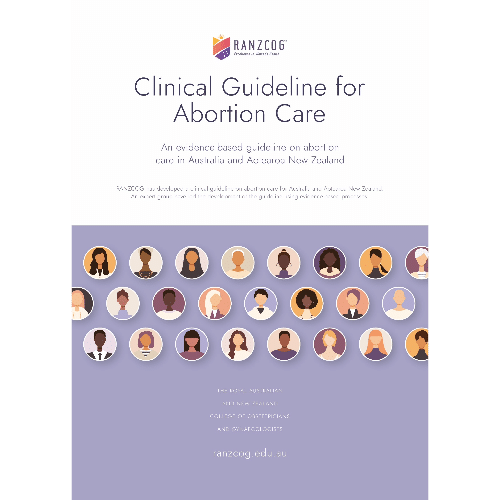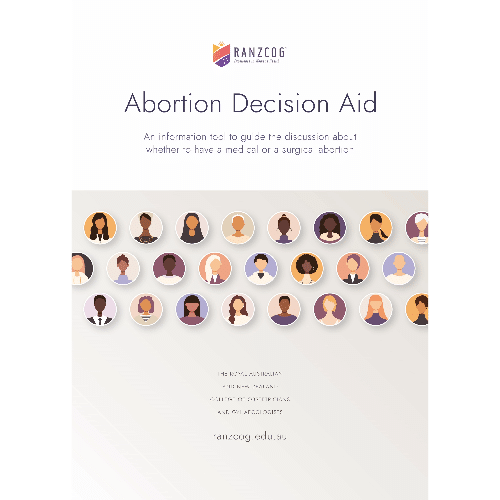Clinical Guideline for Abortion Care
Summary
RANZCOG has published the first binational evidence-based clinical practice guideline on abortion care for Australia and Aotearoa New Zealand.
The purpose of this guideline is to provide evidence-based recommendations to registered health professionals who provide advice and abortion care in Australia and Aotearoa New Zealand. RANZCOG supports equitable access to sexual and reproductive health services, including abortion, a fundamental reproductive health right.
Recent legislative changes in Australia and Aotearoa New Zealand permit abortion to be performed in all jurisdictions, under certain circumstances, by registered health professionals who are working within their approved scope of practice.
Key topics covered in this guideline include:
Telehealth advancements — there is scope for an increased role for telehealth in Early Medical Abortion (EMA); EMA services by telehealth have been reported to be safe and effective
Routine testing — routine testing of blood group for Rh D status is not required for either medical or surgical abortion up to 10 weeks pregnant; the guideline also makes recommendations on use of ultrasound prior to an abortion
Pain relief — all women undergoing a medical or surgical abortion should be offered effective pain relief
Antibiotic prophylaxis — the guideline provides clarity that antibiotic prophylaxis is recommended for all women having a surgical abortion, but is not recommended for women having a medical abortion
Choice of medical or surgical abortion — when considering a medical or a surgical abortion, women should be able to choose the method of abortion most acceptable to them as both methods are safe and effective; RANZCOG has developed a companion document to this guideline to support their decision-making
Appendices
Version history
| Version 1: | October 2023 |
| Review due: | July 2028 |
Background: This guideline was first developed in October 2023. This guideline should be cited as: Clinical Guideline for Abortion Care: An evidence-based guideline on abortion care in Australia and Aotearoa New Zealand (2023). RANZCOG, Melbourne, Australia.
Per the below full disclaimer (also included in the PDF), this work is copyright. Apart from any use as permitted under the Copyright Act 1968, parts of the document can be reproduced by clinicians, hospitals and medical and allied health organisations without permission; however, any use of the materials needs to be acknowledged using the citation above. Requests and enquiries concerning reproduction and rights should be addressed to The Royal Australian and New Zealand College of Obstetricians and Gynaecologists (RANZCOG), College Place, 1 Bowen Crescent, Melbourne, VIC 3004, Australia, or via email to: guideline@ranzcog.edu.au.
The development of this guideline was fully resourced by RANZCOG.
Acknowledgements
RANZCOG wishes to acknowledge the permission of the New Zealand Ministry of Health to access the evidence summaries of the New Zealand Aotearoa Abortion Clinical Guideline (2021). Under Copyright Licence executed on 10th January 2022, the New Zealand Ministry of Health permitted use of the copyright material of which has provided the foundation for the development of the RANZCOG Guideline.
RANZCOG established an Abortion Guideline Development Group (GDG) to develop this guideline. We acknowledge the generous, thoughtful contributions of the members of the GDG listed below.
| Abortion Guideline Development Group (GDG) | |
|---|---|
| Dr Gillian Gibson | Chair and Board member (President Elect) |
| Professor Kirsten Black | A/Chair, SRHSIG Chair |
| Professor Danielle Mazza | Associate (Procedural and Adv. Procedural) Representative |
| Dr Kate Poland | Associate (Procedural and Adv. Procedural) Representative (Rural Health) |
| Dr Dan Wilson | Associate (Procedural and Adv. Procedural) Representative (Rural Health) |
| Dr Anna Hudspith | Member (Aotearoa New Zealand) |
| Dr Catriona Melville | Member |
| A/Professor Patricia Moore | Member |
| Dr Alyce Wilson | Member (Public Health Physician) |
| Ms Kate Chaouki | Midwifery Representative, Australia |
| Dr Ahmad Syahir Mohd Soffi | Trainee representative (First Nation’s services) |
| Dr Vanessa Gray | Trainee/Community Representative (proud Darug woman) |
| Ex officio | |
|---|---|
| Dr Ben Bopp | President, RANZCOG |
| Ms Vase Jovanoska | CEO, RANZCOG |
| Technical team | |
|---|---|
| Professor Cindy Farquhar, University of Auckland | Dean of Research and Policy, RANZCOG |
| A/Professor. Michelle Wise, University of Auckland | Advisor |
| Dr Karyn Anderson, University of Auckland | Research Fellow |
| Mr Sudi Sekhar, RANZCOG | Executive Director, Innovation, Learning and Quality Assurance |
| Ms Jinty Wilson, RANZCOG | Head of Research and Policy |
| Dr Jasmine Schipp, RANZCOG | Research and Policy Senior Coordinator |
Full disclaimer
Purpose
This clinical practice guideline has been developed to provide general advice to practitioners about performing abortion and counselling women who are considering an abortion and should not be relied on as a substitute for proper assessment with respect to the particular circumstances of each case and the needs of any person. It is the responsibility of each practitioner to have regard to the particular circumstances of each case. Clinical management should be responsive to the needs of the individual person and the particular circumstances of each case.
Quality of information
The information available in this guideline is intended as a guide and provided for information purposes only. The information is based on the Australian/Aotearoa New Zealand context using the best available evidence and information at the time of preparation. While the Royal Australian and New Zealand College of Obstetricians and Gynaecologists (RANZCOG) has endeavoured to ensure that information is accurate and current at the time of preparation, it takes no responsibility for matters arising from changed circumstances or information or material that may have become subsequently available. The use of this information is entirely at your own risk and responsibility.
For the avoidance of doubt, the materials were not developed for use by patients, and patients must seek medical advice in relation to any treatment. The material includes the views or recommendations of third parties and does not necessarily reflect the views of RANZCOG or indicate a commitment to a particular course of action.
Third-party sites
Any information linked in this guideline is provided for the user’s convenience and does not constitute an endorsement or a recommendation or indicate a commitment to a particular course of action of this information, material, or content unless specifically stated otherwise.
RANZCOG disclaims, to the maximum extent permitted by law any responsibility and all liability (including without limitation, liability in negligence) to you or any third party for inaccurate, out of context, incomplete or unavailable information contained on the third-party website, or for whether the information contained on those websites is suitable for your needs or the needs of any third party for all expenses, losses, damages and costs incurred.
Exclusion of liability
The College disclaims, to the maximum extent permitted by law, all responsibility and all liability (including without limitation, liability in negligence) to you or any third party for any loss or damage which may result from your or any third party’s use of or reliance of this guideline, including the materials within or referred to throughout this document being in any way inaccurate, out of context, incomplete or unavailable for all expenses, losses, damages, and costs incurred.
Exclusion of warranties
To the maximum extent permitted by law, RANZCOG makes no representation, endorsement or warranty of any kind, expressed or implied in relation to the materials within or referred to throughout this guideline being in any way inaccurate, out of context, incomplete or unavailable for all expenses, losses, damages and costs incurred.
These terms and conditions will be constructed according to and are governed by the laws of Victoria, Australia.
DISCLAIMER
This information is intended to provide general advice to practitioners. This information should not be relied on as a substitute for proper assessment with respect to the particular circumstances of each case and the needs of any patient. This document reflects emerging clinical and scientific advances as of the date issued and is subject to change. The document has been prepared having regard to general circumstances.

